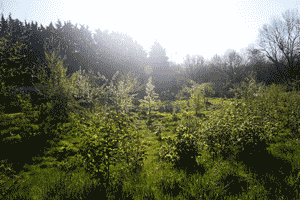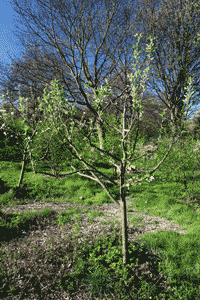Guest post from Seema of Hackney Transition Towns.
Hackney Tree Nursery and Edible Forest Garden, next to Hackney Marsh, is a community space run by volunteers. In 2006, volunteers from Hackney Marshes User Group started a forest garden on the site, as a model for local food production, using permaculture principles.
Forest Gardens are designed to mimic forests by using different layers to provide food and other resources for people and for wildlife. Vertical layers – canopy, understorey, groundcover, soil and root systems – are utilised, just as you would see in natural woodland, but are designed by taking into account existing conditions and choosing plants that meet the identified needs.
Forest gardens are diverse and useful
 Through the use of layers and by mixing crops, a forest garden is very diverse and can contain hundreds of species. Some are used directly as a resource whilst others are indirectly useful, for example by increasing the availability of nutrients for other plants, or attracting insect pollinators. By maximising space and increasing diversity, the potential yield of a forest garden is high and varied.
Through the use of layers and by mixing crops, a forest garden is very diverse and can contain hundreds of species. Some are used directly as a resource whilst others are indirectly useful, for example by increasing the availability of nutrients for other plants, or attracting insect pollinators. By maximising space and increasing diversity, the potential yield of a forest garden is high and varied.
Forest gardens originated in the tropics, and were introduced into temperate regions in the last few decades, attributed to Robert Hart whose garden is located in Shropshire. Allowing sunlight to the understorey layer is more of a challenge in temperate climates, where the light conditions are not as plentiful as in the tropics. This can be addressed through the careful selection and placement of plants.
Self sustaining
 Once established, forest gardens should need minimal human input as they are designed to be self-maintaining. At the site in Hackney, we are still establishing and expanding the forest garden so there is a fair bit of work to do but it is very rewarding and a good learning experience. We already have around 100 species including apple, pear, medlar, elder, blackcurrant, strawberry, kiwi, fig, raspberry, wild garlic, hawthorn, walnut, globe artichoke, nettle, mulberry, plum, rosemary, sage, chives – to name but a few! We have recently ordered some new perennials from the Agroforestry Research Trust and are planning to plant some new herbs, both culinary and medicinal.
Once established, forest gardens should need minimal human input as they are designed to be self-maintaining. At the site in Hackney, we are still establishing and expanding the forest garden so there is a fair bit of work to do but it is very rewarding and a good learning experience. We already have around 100 species including apple, pear, medlar, elder, blackcurrant, strawberry, kiwi, fig, raspberry, wild garlic, hawthorn, walnut, globe artichoke, nettle, mulberry, plum, rosemary, sage, chives – to name but a few! We have recently ordered some new perennials from the Agroforestry Research Trust and are planning to plant some new herbs, both culinary and medicinal.
How we run our site
At our site, the forest garden and the community tree nursery operate together and earlier this year we were joined by Growing Communities, a local food growing social enterprise. Between the three projects, the site offers really good opportunities to volunteer and learn more about sustainable food growing. It is a fantastic example of what can be achieved in an urban environment and is a lovely place to spend time and be part of a community.
As well as regular weekly volunteer sessions, we run courses, workshops for school groups and other events. This year we were awarded a grant from the Local Food Fund to run a year-long Forest Gardening course. Through this we have been able to share knowledge and expertise with the aim of helping to set up more forest gardens and local food growing projects in London.
A joy to see them develop
The forest garden is continually changing and it’s a joy to see it change through the seasons and over time as plants become more established. And of course, we enjoy eating (and sharing) the fruits of our labour and are lucky to have such delicious, fresh and sometimes unusual produce. A forest in a city is a wonderful and surprising delight!

